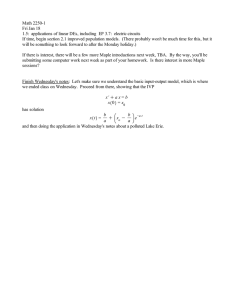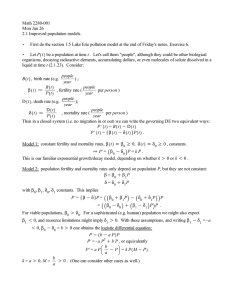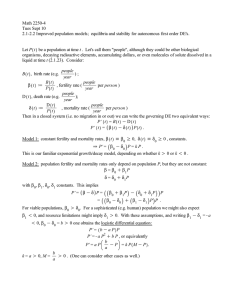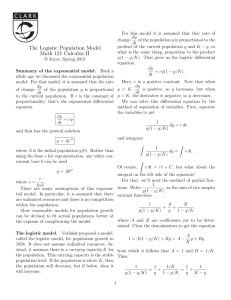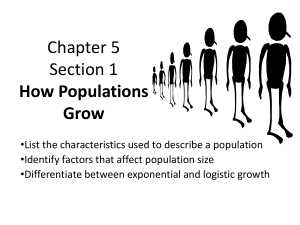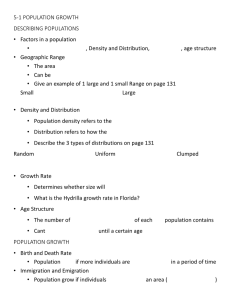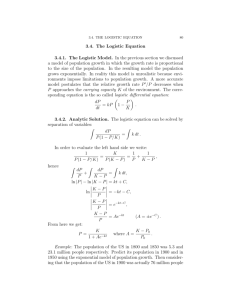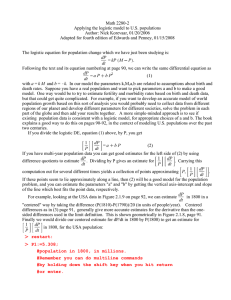Math 2250-1 Fri Aug 31 2.1: improved population models
advertisement
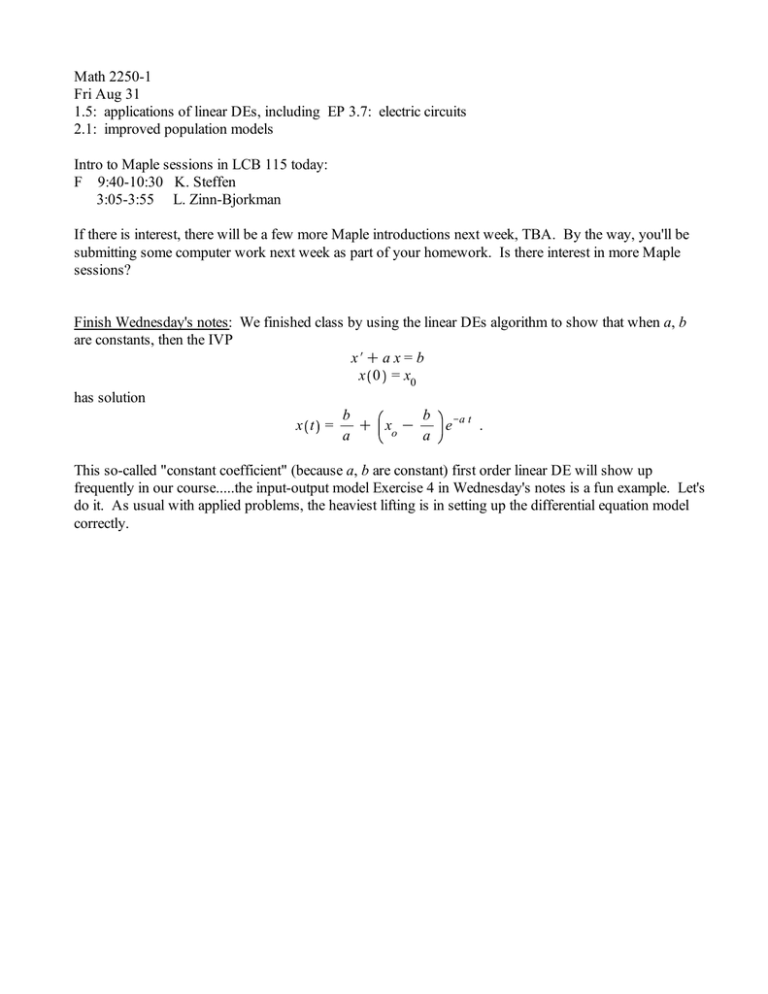
Math 2250-1 Fri Aug 31 1.5: applications of linear DEs, including EP 3.7: electric circuits 2.1: improved population models Intro to Maple sessions in LCB 115 today: F 9:40-10:30 K. Steffen 3:05-3:55 L. Zinn-Bjorkman If there is interest, there will be a few more Maple introductions next week, TBA. By the way, you'll be submitting some computer work next week as part of your homework. Is there interest in more Maple sessions? Finish Wednesday's notes: We finished class by using the linear DEs algorithm to show that when a, b are constants, then the IVP x#C a x = b x 0 = x0 has solution b b Ka t x t = C xo K e . a a This so-called "constant coefficient" (because a, b are constant) first order linear DE will show up frequently in our course.....the input-output model Exercise 4 in Wednesday's notes is a fun example. Let's do it. As usual with applied problems, the heaviest lifting is in setting up the differential equation model correctly. EP 3.7 This is a supplementary section. If you bought the new book packet at the bookstore you have a copy. For those of you that don't have a hard copy, I've posted a .pdf on our homework page. Often the same DE can arise in completely different-looking situations. For example, first order linear DE's also arise (as special cases of second order linear DE's) in simple RLC circuit modeling. http://cnx.org/content/m21475/latest/pic012.png Charge Q t coulombs accumulates on the capacitor, at a rate I t i t in the diagram above) amperes (coulombs/sec), i.e Q # t = I t . Kirchoff's Law: The sum of the voltage drops around any closed circuit loop equals the applied voltage V t (volts). The units of voltage are energy units - Kirchoff's Law says that a test particle traversing any closed loop returns with the same potential energy level it started with: 1 For Q t : L Q ## t C R Q # t C Q t =V t C 1 For I t : L I## t C R I# t C I t = V# t C if no inductor, or if no capacitor, then Kirchoff's Law yields 1st order linear DE's, as below: Exercise 1: Consider the R K L circuit below, in which a switch is thrown at time t = 0. Assume the voltage V is constant, and I 0 = 0 . Find I t . Interpret your results. http://www.intmath.com/differential-equations/5-rl-circuits.php 2.1 Improved population models Let P t be a population at time t . Let's call them "people", although they could be other biological organisms, decaying radioactive elements, accumulating dollars, or even molecules of solute dissolved in a liquid at time t (2.1.23). Consider: B t , birth rate (e.g. b t d B t P t people ); year , fertility rate ( D t , death rate (e.g. people per person ) year people ); year D t people , morbidity rate ( per person ) P t year Then in a closed system (i.e. no migration in or out) we can write the governing DE two equivalent ways: P# t = B t K D t P# t = b t K d t P t . d t d Model 1: constant fertility and morbidity rates, b t h b 0 R 0, d t h d0 R 0 , constants. 0 P#= b 0 K d0 P = k P . This is our familiar exponential growth/decay model, depending on whether k O 0 or k ! 0 . Model 2: population fertility and morbidity rates only depend on population P, but they are not constant: b = b0 C b1P d = d0 C d1 P with b 0 , b 1 , d0 , d1 constants. This implies P#= b K d P = = b 0 C b 1 P K d0 C d1 P P b 0 K d0 C b 1 K d1 P P . For viable populations, b 0 O d0 . For a sophisticated (e.g. human) population we might also expect b 1 ! 0, and resource limitations might imply d1 O 0. With these assumptions, and writing b 1 K d1 =Ka ! 0, b 0 K d0 = b O 0 one obtains the logistic differential equation: P#= b K a P P P#=Ka P2 C b P , or equivalently b P#= a P KP = k P MKP . a b k = a O 0, M = O 0 . (One can consider other cases as well.) a Exercise 2: Discuss qualitative features of the slope field for the logistic differential equation for P = P t : P#= k P M K P a) There are two constant ("equilibrium") solutions. What are they? b) Evaluate the sign and magnitude of the slope function f P, t = k P M K P , in order to understand and be able to recreate the two diagrams below. One is a qualititative picture of the slope field, in the t K P plane. The diagram to the left of it, called the phase diagram , is just a P number line with arrows indicating whether P t is increasing or decreasing on the intervals between the constant solutions. c) When discussing the logistic equation, the value M is called the "carrying capacity" of the (ecological or other) system. Discuss why this is a good way to describe M . Hint: if P 0 = P0 O 0 , and P t solves the logistic equation, what is the apparent value of t lim P t ? /N Exercise 3: Solve the logistic DE IVP P#= k P M K P P 0 = P0 via separation of variables. Verify that the solution formula is consistent with the slope field and phase diagram discussion from exercise 1. Hint: You should find that MP0 P t = . M K P0 eKMkt C P0 Solution (we worked this out in class): dP P PKM =Kk dt By partial fractions, 1 1 1 1 = K . P PKM M PKM P Use this expansion and multiply both sides of the separated DE by M to obtain 1 1 K dP =KkM dt . PKM P Integrate: ln P K M K ln P =KMkt C C1 PKM ln =KMkt C C1 P exponentiate: PKM = C2 eKMkt P Since the left-side is continuous PKM = C eKMkt (C = C2 or C =KC2 ) P (At t = 0 we see that P0 K M = C .) P0 Now, solve for P t by multiplying both sides of of the second to last equation by P t K M: P K M = CeKMkt P Collect P t terms on left, and add M to both sides: P K CeKMkt P = M P 1 K CeKMkt = M M P= . 1 K CeKMkt Plug in C and simplify: MP0 M P= = P0 K M KMkt P0 K P0 K M eKMkt 1K e P0 P t = MP0 P0 C M K P0 eKMkt . Finally, because t lim eKMkt = 0 , we see that /N lim P t = t /N MP0 P0 = M as expected. Note: If P0 O 0 the denominator stays positive for t R 0, so we know that the formula for P t is a differentiable function for all t O 0. (If the denominator became zero, the function would blow up at the corresponding vertical asymptote.) To check that the denominator stays positive check that (i) if P0 ! M then the denominator is a sum of two positive terms; if P0 = M the separation algorithm actually fails because you divided by 0 to get started but the formula actually recovers the constant equilibrium solution P t h M; and if P0 O M then M K P0 ! P0 so the second term in the denominator can never be negative enough to cancel out the positive P0 , for t O 0 .) Application! The Belgian demographer P.F. Verhulst introduced the logistic model around 1840, as a tool for studying human population growth. Our text demonstrates its superiority to the simple exponential growth model, and also illustrates why mathematical modelers must always exercise care, by comparing the two models to actual U.S. population data. > restart : # clear memory Digits d 5 : #work with 5 significant digits > pops d 1800, 5.3 , 1810, 7.2 , 1820, 9.6 , 1830, 12.9 , 1840, 17.1 , 1850, 23.2 , 1860, 31.4 , 1870, 38.6 , 1880, 50.2 , 1890, 63.0 , 1900, 76.2 , 1910, 92.2 , 1920, 106.0 , 1930, 123.2 , 1940, 132.2 , 1950, 151.3 , 1960, 179.3 , 1970, 203.3 , 1980, 225.6 , 1990, 248.7 , 2000, 281.4 , 2010, 308. : #I added 2010 - between 306-313 # I used shift-enter to enter more than one line of information # before executing the command. > with plots : # plotting library of commands pointplot pops, title = `U.S. population through time` ; U.S. population through time 300 200 100 1800 1850 1900 1950 2000 > Unlike Verhulst, the book uses data from 1800, 1850 and 1900 to get constants in our two models. We let t=0 correspond to 1800. Exponential Model: For the exponential growth model P t = P0 er t we use the 1800 and 1900 data to get values for P0 and r : > P0 d 5.308; solve P0$exp r$100 = 76.212, r ; P0 := 5.308 0.026643 > P1 d t/5.308$ exp .02664$ t ;#exponential model -eqtn (9) page 83 P1 := t/5.308 e0.02664 t > (1) (2) Logistic Model: We get P0 from 1800, and use the 1850 and 1900 data to find k and M : > P2 d t/M$P0 / P0 C MKP0 $exp KM$k$t ; # logistic solution we worked out M P0 P2 := t/ P0 C M K P0 eKM k t > solve (3) P2 50 = 23.192, P2 100 = 76.212 , M, k ; M = 188.12, k = 0.00016772 (4) > M d 188.12; k d .16772e-3; P2 t ; #should be our logistic model function, #equation (11) page 84. M := 188.12 k := 0.00016772 998.54 (5) 5.308 C 182.81 eK0.031551 t > Now compare the two models with the real data, and discuss. The exponential model takes no account of the fact that the U.S. has only finite resources. Any ideas on why the logistic model begins to fail (with our parameters) around 1950? > plot1 d plot P1 tK1800 , t = 1800 ..1950, color = black, linestyle = 3 : #this linestyle gives dashes for the exponential curve plot2 d plot P2 tK1800 , t = 1800 ..2010, color = black : plot3 d pointplot pops, symbol = cross : display plot1, plot2, plot3 , title = `U.S. population data and models` ; U.S. population data and models 300 250 200 150 100 50 1800 > 1850 1900 t 1950 2000
